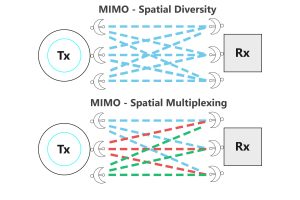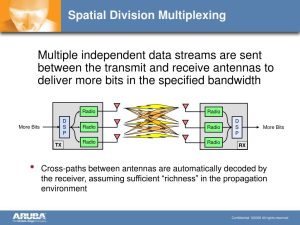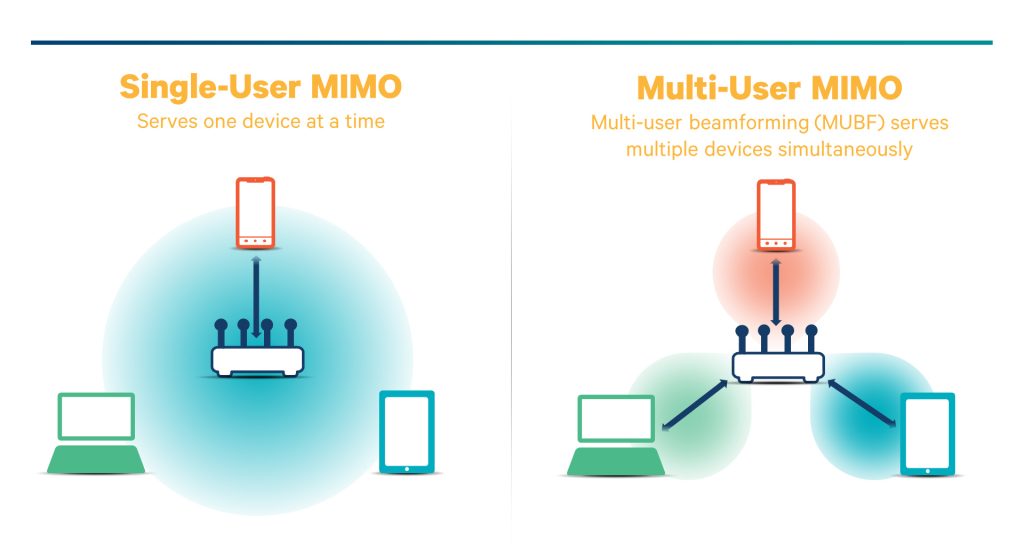MIMO technology has completely upended the wireless communication game, allowing for simultaneous transmission and reception of multiple antennas. Spatial multiplexing is quite the boon to MIMO tech in single-user systems — it’s a surefire way to increase throughput without any pesky additional bandwidth or power requirements. Essentially, by utilizing several antennas that send different data streams, spatial multiplexing can multiply your wireless channel capacity with ease.

Beamforming and transmit diversity are two other techniques that can really boost your wireless throughput in MIMO systems. Beamforming uses antenna arrays to concentrate all transmission energy towards specific areas, which results in an improved signal quality as well as reduced interference. Meanwhile, transmit diversity sends out redundant copies of identical data over various antennas with differing propagation paths; this helps combat fading effects caused by reflections and obstacles.
Antenna arrays play a pivotal role when it comes to enhancing spatial multiplexing for increased data rates. By designing an antenna system carefully, you’ll be able to create orthogonal channels that allow independent transmission of numerous data streams sans interference between them. This will lead to higher spectral efficiency along with improved coverage compared to traditional single-antenna setups. And if you’re looking for even better signal quality? Just use those spatial streams! You’ll be able take advantage of multi-path propagation effects through intricate modulation schemes.
Overall, MIMO technology boasts many advantages when it comes down (or up?) improving capacity and efficiency within wireless networks via dynamic beamforming weights based on changing environmental conditions or otherwise — but only if accurate channel state information feedback from both transmitter and receiver sides is present! Consequently ongoing research aims at developing more advanced algorithms focused on CSI estimation & optimization in both MIMO & spatial multiplexing systems alike…
Spatial Multiplexing and Its Benefits in Single-User MIMO Systems.
Contents
- 1 Spatial Multiplexing and Its Benefits in Single-User MIMO Systems.
- 2 Enhancing Wireless Throughput with Beamforming and Transmit Diversity.
- 3 The Role of Antenna Arrays in Spatial Multiplexing for Increased Data Rates.
- 4 Multi-User MIMO Systems: Improving Capacity and Efficiency in Wireless Networks.
- 5 Exploring the Use of Spatial Streams for Improved Signal Quality in MIMO Technology.
- 6 The Importance of Channel State Information in MIMO and Spatial Multiplexing Systems.
- 7 Overcoming Limitations: Maximizing Data Transmission in Single-User MIMO Systems.
The enigmatic technique of spatial multiplexing is the key to unlocking the potential of single-user MIMO systems. By utilizing multiple transmit antennas, this elusive method enables the transmission of several data streams over separate spatial paths, leveraging the multipath propagation phenomenon to increase wireless access capacity and throughput. In essence, it’s an ingenious way of maximizing available bandwidth by enabling simultaneous transmission and reception of independent data streams.

However, implementing spatial multiplexing in SU-MIMO systems requires more than just multiple transmit antennas; it also necessitates corresponding receive antennas at the receiver end. The number of antenna pairs directly impacts how many independent data streams can be transmitted simultaneously – a crucial factor that affects overall system performance in terms of both throughput and reliability. Additionally, using beamforming techniques to focus energy towards specific directions or users further augments signal quality while minimizing interference.
While SU-MIMO does have limitations due to its reliance on a single user’s channel characteristics, it still provides significant benefits over traditional SISO (single-input-single-output) systems. Nevertheless, recent advancements in MU-MIMO (multi-user MIMO) technology have revolutionized simultaneous transmission by employing spatial division techniques similar to those used in SU-MIMO but with added complexity through scheduling algorithms that determine which user gets served when based on their channel conditions. It’s all quite perplexing yet intriguingly fascinating!
Enhancing Wireless Throughput with Beamforming and Transmit Diversity.
The perplexing and bursty world of wireless throughput is often enhanced through the use of beamforming and transmit diversity techniques in both single-user MIMO and multi-user MIMO systems. The mind-boggling process of beamforming entails directing a signal towards a specific receiver by using multiple antennas at the transmitter, which can be incredibly useful when contending with interference from other signals or obstructions.
On the other hand, transmit diversity involves transmitting several copies of a signal over various paths utilizing numerous antennas at the transmitter. This technique can help to improve signal-to-noise ratio (SNR) and mitigate errors caused by fading or interference.
When implementing these techniques, an antenna array at the transmitter comes into play; however, choosing how many antennas are needed depends on several factors such as available bandwidth, desired throughput, and user requirements. In general, increasing the number of antennas in a MIMO system leads to superior performance resulting in higher data rates.
Overall, it’s clear that beamforming and transmit diversity are key players when it comes to improving wireless throughput for both single-user MIMO and multi-user MIMO systems. By optimizing multiple antenna usage on either end of a transmission link simultaneously achieving faster data transfer speeds with fewer errors or dropped connections becomes possible- mind-blowing!
The Role of Antenna Arrays in Spatial Multiplexing for Increased Data Rates.
The utilization of antenna arrays is pivotal in the realm of spatial multiplexing, leading to an upsurge in data rates. By employing multiple antennas, the transmission quality can be enhanced while reducing interference caused by multipath propagation. This consequential enhancement results in a surge towards higher data rates achievable through wireless communication channels.
In single-user MIMO systems, antenna arrays are utilized to augment wireless throughput via beamforming and transmit diversity. Beamforming concentrates transmitted energy towards a specific direction, improving signal-to-noise ratio (SNR) at the receiving end. Transmit diversity involves transmitting diverse data streams from each antenna to combat fading effects resulting from multipath propagation.
Antenna arrays also offer benefits for multi-user MIMO systems as they bolster capacity and efficiency within wireless networks. Spatial streams enable distinct users to receive their own exceptional set of signals simultaneously without causing interference with one another; this leads to an overall increase in network throughput. However, channel state information (CSI) plays a crucial role in these types of systems since it enables accurate beamforming and spatial stream allocation based on user location and movement within the coverage area – truly perplexing!
Multi-User MIMO Systems: Improving Capacity and Efficiency in Wireless Networks.
Multi-User MIMO (MU-MIMO) is an awe-inspiring technology that has revolutionized the way data transmission and reception take place on the same frequency band. Its unparalleled ability to transmit multiple streams of data concurrently using four or more antennas is a game-changer for wireless networks, paving the way for unfathomable efficiency.
In contrast to Single-User MIMO (SU-MIMO), which employs only one antenna for both transmitting and receiving data, MU-MIMO systems can use many antennas – up to 8 spatial streams in MU-MIMO mode as supported by the 802.11ac standard! This means that up to eight devices can communicate simultaneously with an access point via different sets of antennas.
The most significant advantage of this technology lies in its ability to reduce signal interference between devices on a wireless network. With SU-MIMO systems, each device must wait patiently before transmitting or receiving data, resulting in delays and decreased throughput. On the other hand, with MU-MIMO systems, several devices can transmit and receive signals at once without causing any disruptions.
Achieving simultaneous transmission without interference requires advanced techniques such as Transmit Beamforming (TxBF) and Transmit Diversity (TD). TxBF adjusts antenna phase patterns based on client feedback about their channel conditions so that transmitted signals are focused on specific clients while minimizing interference with others. TD involves sending redundant copies of information through space using two or more antennas at both ends of the link.
Overall, Multi-User MIMO technology has become increasingly vital in modern wireless networks due to its remarkable capacity-increasing capability while maintaining high levels of performance even under heavy traffic loads. By utilizing multiple antennas for transmitting/receiving signals along with advanced signal processing techniques like beamforming and diversity schemes; it enables better utilization of available spectrum resources leading towards improved user experience across different environments!
Exploring the Use of Spatial Streams for Improved Signal Quality in MIMO Technology.
The utilization of spatial streams is an integral component of MIMO technology, which boasts the ability to amplify signal quality in wireless communications. By harnessing the power of multiple transmit antennas, spatial multiplexing enables a single user to receive multiple data streams simultaneously over the same frequency band. Similarly, employing numerous receive antennas on the receiver’s end facilitates improved signal quality and enhanced diversity.
However, it’s worth noting that although spatial multiplexing can augment throughput and capacity in downlink scenarios where there are several transmit antennas and a solo user with multiple receive antennas, its multiplexing gain remains restricted by the number of available receive antennas. In order to further improve performance levels beyond these limitations, multi-output (MIMO) and spatial multi-output (SMO) techniques come into play- both utilize additional antenna elements per user.
In practice settings, up to three concurrent spatial streams can be transmitted using MIMO technology; however this figure depends on various factors such as channel state information and available bandwidth. The number of utilized spatial streams relies heavily upon both transmit/receive antenna numbers as well as prevailing channel conditions. If implemented correctly, incorporating Spatial Data Streams has been shown to yield considerable enhancements regarding throughput compared to traditional SISO systems!
The Importance of Channel State Information in MIMO and Spatial Multiplexing Systems.
The importance of Channel State Information (CSI) cannot be overstated in the realm of MIMO and spatial multiplexing systems. In wireless networks, CSI refers to a deep understanding of the channel between users and base stations. It reveals critical information about signal transmission and reception, including phase and amplitude.
Antenna diversity is one technique that can harness CSI to enhance wireless access. By utilizing multiple antennas at both ends of communication- either single users with numerous antennas or multiple users with a single antenna- it becomes possible to transmit streams of data simultaneously. This phenomenon is known as spatial multiplexing, which can escalate user throughput by transmitting more data per unit time.
Additionally, beamforming technology in MIMO systems relies heavily on CSI for optimal transmission/reception quality towards specific users through directional beams while mitigating interference from other sources.
In conclusion, comprehending CSI plays an indispensable role in maximizing data transmission rates in MIMO and spatial multiplexing systems. Leveraging this knowledge enables improved wireless access via techniques such as antenna diversity and beamforming technologies that are beneficial for individual users as well as cellular networks overall.
Overcoming Limitations: Maximizing Data Transmission in Single-User MIMO Systems.
In the realm of single-user MIMO systems, there exists a vexing limitation that restricts data transmission to a certain extent. This limitation is governed by the number of transmitting antennas and multiple transmission points. However, intrepid advancements in antenna technology have paved the way for better signal-to-noise ratios and higher antenna gains, thereby circumventing this restriction. Through deft utilization of multiple-input and multiple-output (MIMO) techniques, even solitary systems can achieve elevated throughput rates.
To fully optimize data transmission in single-user MIMO systems, it behooves us to explore linkages between transmitter and receiver antennas with great care. With spatial multiplexing techniques at our disposal, we can increase the number of transmitting antennas while simultaneously augmenting communication quality betwixt them – greatly expanding wireless network capacity for data transfer.
Yet another technique that ensconces itself as an effective solution to limitations within single-user MIMO systems is beamforming – which involves directing signals towards specific receivers or locations. By employing directional antenna arrays that focus energy on particular receiver antennae while minimizing interference from external sources; beamforming optimizes channel state information (CSI), further improving signal strength and enabling more efficient use of available bandwidths.


